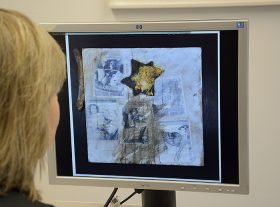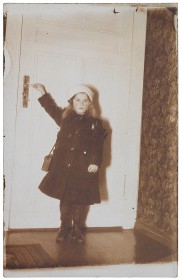This year’s “Hellas Filmbox Berlin” (18–22 January 2017), a Greek film festival established in 2015 to highlight the current Greek film scene and present it to a German audience, features five films in the special history section on Greek Jews in the Holocaust and Greece under German occupation: → continue reading
Greek Jews During the Nazi Occupation
Boris Lurie – Trying Out an Approach for High School Students

Nina Wilkens contemplating the collage “Found objects on flat cardboard box” on her computer screen; Jewish Museum Berlin, photo: Svenja Kutscher
Five black and white photographs of a scantily-clad woman, legs spread open, in various suggestive poses. The pictures smudged and stuck askew onto white cardboard. On top, a Star of David partly smeared with yellow paint. A brown dildo is fastened next to the cardboard. This constellation of things looks at first glance like useless trash. Objects left on the ground, covered with their share of grime, and now lying here piled on top of one another. This work by Boris Lurie from our current exhibition “No Compromises! The Art of Boris Lurie” (further information about the exhibition on our website) has no name and its date is ambiguous.
When I started thinking, around a year ago, about a pedagogical program on Boris Lurie, I got stuck on this picture as I sat at my computer clicking through images of the works that were being considered for the exhibit. I was confused by my own reaction to this collage of two- and three-dimensional objects: vacillating between disgust and uncertainty. I had the words “obscene” and “tasteless” on the tip of my tongue but found them unsuitable. The image hurt. I wondered how students would react to Boris Lurie’s art. → continue reading
An Unsolvable Mystery?
A Photo Collection Found Hiding in Berlin-Friedrichshain
Every time I open a new folder of photos, I can’t know what’s waiting for me – what faces I’ll find or fates will be revealed. Images are often part of a larger collection, consisting of documents, everyday articles and artwork, for which we already know the biographies of those pictured or can further research. Such was the case, for example, of the cabaret artist, Olga Irén Fröhlich, whom I’ve written about before on this blog. This time, however, the people in the photographs will remain unknown to me; I won’t be able to attach names or histories to them. Perhaps you can!
It’s not out of the ordinary to work with collections that have been in the Museum’s possession for decades. → continue reading
